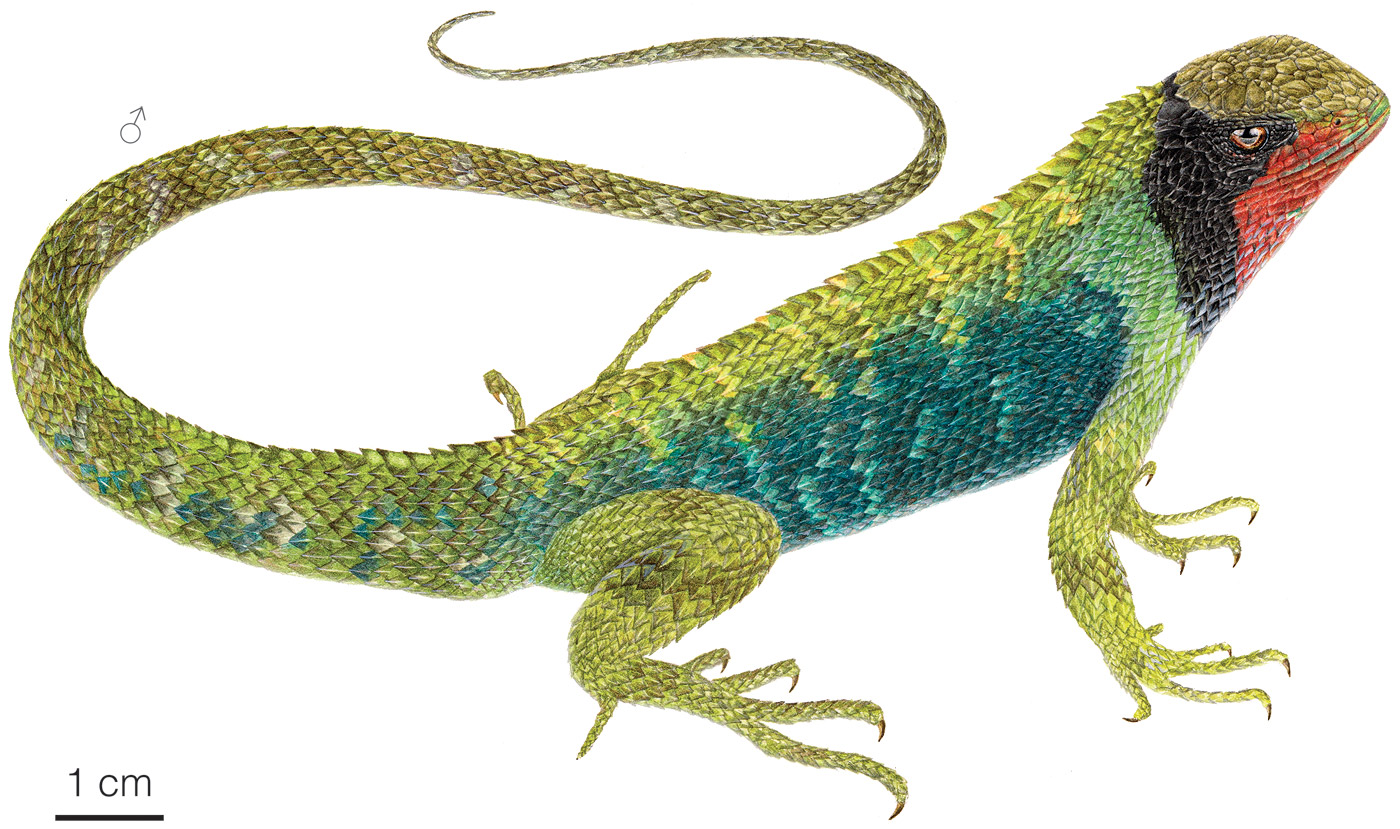Published October 24, 2023. Updated January 27, 2024. Open access. | Purchase book ❯ |
Thorny Whorltail-Iguana (Stenocercus aculeatus)
Reptiles of Ecuador | Sauria | Tropiduridae | Stenocercus aculeatus
English common name: Thorny Whorltail-Iguana.
Spanish common name: Guagsa cornuda espinosa.
Recognition: ♂♂ 27.8 cmMaximum distance from the snout to the tip of the tail. Snout–vent length=10.3 cm. ♀♀ 24.5 cmMaximum distance from the snout to the tip of the tail. Snout–vent length=9.1 cm..1–3 The Thorny Whorltail-Iguana (Stenocercus aculeatus) differs from other lizards in its area of distribution by having keeled overlapping dorsal scales with pointed ends and a black face mask with a contrasting red throat patch (Fig. 1).1–3 Stenocercus aculeatus resembles S. angulifer, but it can be differentiated from the latter by having a much deeper postfemoral mite pocket and a wider posthumeral mite pocket opening.3 Furthermore, the tail in males of S. angulifer is strongly laterally compressed, more than twice than in males of S. aculeatus of similar size.3

Figure 1: Illustration of an adult male individual of Stenocercus aculeatus.
Natural history: Stenocercus aculeatus is an extremely rare lizard that inhabits evergreen foothill forest, gallery forests, and pastures with scattered trees.1,2 These reptiles need extended periods of direct sunlight hitting the ground in order to become active.4 On sunny days, they can often be observed basking at the base of tall grass near rocky walls or foraging along trails in semi-open areas.1,2 At night, they roost on grass blades 50–80 cm above the ground.1.2 When disturbed, these timid reptiles swiftly retreat into dense bushes.1
Conservation: Least Concern Believed to be safe from extinction given current circumstances..5 Stenocercus aculeatus is listed in this category because the species is distributed over an area greater than 20,000 km2 along the Cordillera del Cóndor, a region that retains substantial expanses of pristine, uninterrupted forested areas.5 Unfortunately, an ever increasing percentage of the mountain range is succumbing to clearance, driven by the expansion of large-scale open-pit mining operations.6 Consequently, S. aculeatus may warrant inclusion in a threatened category in the forthcoming years if deforestation in the Cordillera del Cóndor persists.
Distribution: Stenocercus aculeatus is distributed along the Amazonian slopes of the Andes in southeastern Ecuador (Fig. 2) and northern Peru, particularly along the Cordillera del Cóndor.

Figure 2: Distribution of Stenocercus aculeatus in Ecuador. See Appendix 1 for a complete list of the presence localities included in the map.
Etymology: The generic name Stenocercus, which comes from the Greek words stenos (=narrow) and kerkos (=tail), refers to the laterally-compressed tail in some members of this genus, which contrasts with the dorsally flattened tail of other Tropiduridae.7 The specific epithet aculeatus comes from the Latin aculeus (=sharp-pointed) and the suffix -atus (=provided with),8 and probably refers to the projected dorsal scales.
See it in the wild: Thorny Whorltail-Iguanas are a rarity, and spotting them in their natural habitat is no simple task. Even in the three localities in Ecuador where the species has been sighted, repeat visits have yielded no further observations. To maximize the chances of encountering these lizards, the best approach is to venture out during the hot mid-day hours, a time when individuals are actively on the move and basking in semi-open riverside forests.
Authors: Amanda QuezadaaAffiliation: Tropical Herping (TH), Quito, Ecuador.,bAffiliation: Laboratorio de Herpetología, Universidad del Azuay, Cuenca, Ecuador. and Alejandro ArteagacAffiliation: Fundación Khamai, Reserva Arlequín, Ecoruta Paseo del Quinde km 56, Santa Rosa de Mindo, Pichincha 171202, Ecuador.
Illustrator: Valentina Nieto Fernández
How to cite? Quezada A, Arteaga A (2023) Thorny Whorltail-Iguana (Stenocercus aculeatus). In: Arteaga A, Bustamante L, Vieira J (Eds) Reptiles of Ecuador: Life in the middle of the world. Available from: www.reptilesofecuador.com. DOI: 10.47051/IZSY2134
Literature cited:
- Venegas PJ, García-Ayachi LA, Chávez-Arribasplata JC, Chávez G, Wong I, García-Bravo A (2020) Four new species of Stenocercus Duméril & Bibron, 1837 (Squamata, Iguania) from the Department of Amazonas in northeastern Peru. Evolutionary Systematics 4: 79–108. DOI: 10.3897/evolsyst.4.57578
- Falcón-Reibán JM, Núñez D, Sozoranga-Farez JA, Sánchez-Nivicela JC (2022) Nuevas observaciones y ampliación en la distribución de Stenocercus aculeatus (Iguanidae: Tropidurinae) en el sur de Ecuador. Avances en Ciencias e Ingeniería 14: 1–8. DOI: 10.18272/aci.v14i2.2717
- Torres-Carvajal O (2007) A taxonomic revision of South American Stenocercus (Squamata: iguania) lizards. Herpetological Monographs 21: 76–178. DOI: 10.1655/06-001.1
- Field notes, Reptiles of Ecuador book project.
- Yánez-Muñoz M, Cisneros-Heredia DF, Brito J (2017) Stenocercus aculeatus. The IUCN Red List of threatened species. Available from: www.iucnredlist.org. DOI: 10.2305/IUCN.UK.2017-2.RLTS.T178414A48674303.en
- Chicaiza G (2010) El enclave minero de la Cordillera del Cóndor. Acción Ecológica, Quito, 39 pp.
- Duméril AMC, Bibron G (1837) Erpétologie générale ou Histoire Naturelle complète des Reptiles. Librairie Encyclopédique de Roret, Paris, 571 pp. DOI: 10.5962/bhl.title.45973
- Brown RW (1956) Composition of scientific words. Smithsonian Books, Washington D.C., 882 pp.
Appendix 1: Locality data used to create the distribution map of Stenocercus aculeatus in Ecuador (Fig. 2). Go to the section on symbols and abbreviations for a list of acronyms used.
| Country | Province | Locality | Source |
| Ecuador | Zamora Chinchipe | Chorrillos | Falcón et al. 2022 |
| Ecuador | Zamora Chinchipe | El Pangui | Falcón et al. 2022 |
| Ecuador | Zamora Chinchipe | Soapaca | Falcón et al. 2022 |
| Perú | Amazonas | Bongará | Venegas et al. 2020 |
| Perú | La Libertad | Pampa Seca | Torres-Carvajal 2007 |
| Perú | Loreto | Between Moyobamba and Cahuapanas | Torres-Carvajal 2007 |
| Perú | Loreto | Icuta | Torres-Carvajal 2007 |
| Perú | San Martín | Cerro Patricia | Venegas et al. 2020 |
| Perú | San Martín | Moyobamba | O’Shaughnessy 1879 |